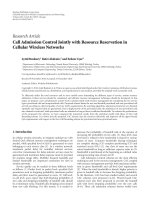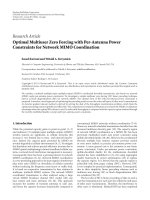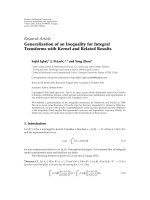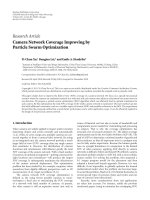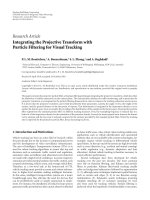báo cáo hóa học:" Research Article Second-Order Boundary Value Problem with Integral Boundary Conditions" docx
Bạn đang xem bản rút gọn của tài liệu. Xem và tải ngay bản đầy đủ của tài liệu tại đây (480.04 KB, 9 trang )
Hindawi Publishing Corporation
Boundary Value Problems
Volume 2011, Article ID 260309, 9 pages
doi:10.1155/2011/260309
Research Article
Second-Order Boundary Value Problem with
Integral Boundary Conditions
Mouffak Benchohra,
1
Juan J. Nieto,
2
and Abdelghani Ouahab
1
1
Department of Mathematics, University of Sidi Bel Abbes, BP 89, 2000 Sidi Bel Abbe, Algeria
2
Departamento de An
´
alisis Matem
´
atico, Facultad de Matem
´
aticas, Universidad de Santiago de Compostela,
15782 Santiago de Compostela, Spain
Correspondence should be addressed to Mouffak Benchohra,
Received 28 May 2010; Revised 1 August 2010; Accepted 1 October 2010
Academic Editor: Gennaro Infante
Copyright q 2011 Mouffak Benchohra et al. This is an open access article distributed under
the Creative Commons Attribution License, which permits unrestricted use, distribution, and
reproduction in any medium, provided the original work is properly cited.
The nonlinear alternative of the Leray Schauder type and the Banach contraction principle are
used to investigate the existence of solutions for second-order differential equations with integral
boundary conditions. The compactness of solutions set is also investigated.
1. Introduction
This paper is concerned with the existence of solutions for the second-order boundary value
problem
−y
t
f
t, y
t
, a.e.t∈
0, 1
,
y
0
0,y
1
1
0
g
s
y
s
ds,
1.1
where f : 0, 1 × R → R is a given function and g : 0, 1 → R is an integrable function.
Boundary value problems with integral boundary conditions constitute a very
interesting and important class of problems. They include two, three, multipoint, and
nonlocal boundary value problems as special cases. For boundary value problems with
integral boundary conditions and comments on their importance, we refer the reader to the
papers 1–9 and the references therein. Moreover, boundary value problems with integral
boundary conditions have been studied by a number of authors, for example 10–14.
The goal of this paper is to give existence and uniqueness results for the problem 1.1.
2 Boundary Value Problems
Our approach here is based on the Banach contraction principle and the Leray-Schauder
alternative 15.
2. Preliminaries
In this section, we introduce notations, definitions, and preliminary facts that will be used
in the remainder of this paper. Let AC
1
0, 1, R be the space of differentiable functions y :
0, 1 → R, whose first derivative, y
, is absolutely continuous.
We take C0, 1, R to be the Banach space of all continuous functions from 0, 1 into
R with the norm
y
∞
sup
y
t
:0≤ t ≤ 1
, 2.1
and we let L
1
0, 1, R denote the Banach space of functions y : 0, 1 → R that are Lebesgue
integrable with norm
y
L
1
1
0
y
t
dt. 2.2
Definition 2.1. A map f : 0, 1 × R → R is said to be L
1
-Carath
´
eodory if
i t → ft, u is measurable for each u ∈ R,
ii u → ft, u is continuous for almost each t ∈ 0, 1,
iii for every r>0 there exists h
r
∈ L
1
0, 1, R such that
f
t, u
≤ h
r
t
for a.e.t∈
0, 1
and all
|
u
|
≤ r. 2.3
3. Existence and Uniqueness Results
Definition 3.1. A function y ∈ AC
1
0, 1, R is said to be a solution of 1.1 if y satisfies 1.1.
In what follows one assumes that g
∗
1
0
sgsds
/
1. One needs the following
auxiliary result.
Lemma 3.2. .Letσ : L
1
0, 1, R. Then the function defined by
y
t
1
0
H
t, s
σ
s
ds 3.1
is the unique solution of the boundary value problem
−y
t
σ
t
, a.e.t∈
0, 1
,
y
0
0,y
1
1
0
g
s
y
s
ds,
3.2
Boundary Value Problems 3
where
H
t, s
G
t, s
t
1 −
1
0
sg
s
ds
1
0
G
r, s
g
r
dr,
G
t, s
⎧
⎨
⎩
s
1 − t
if 0 ≤ s ≤ t ≤ 1,
t
1 − s
if 0 ≤ t ≤ s ≤ 1.
3.3
Proof. Let y be a solution of the problem 3.2. Then integratingly, we obtain
y
t
y
0
ty
0
−
t
0
t − s
σ
s
ds,
y
1
y
0
−
1
0
1 − s
σ
s
ds.
3.4
Hence
y
t
1
0
tg
s
y
s
ds
1
0
t
1 − s
σ
s
ds −
t
0
t − s
σ
s
ds, 3.5
y
t
1
0
tg
s
y
s
ds
1
0
G
t, s
σ
s
ds, 3.6
where
G
t, s
⎧
⎨
⎩
s
1 − t
if 0 ≤ s ≤ t ≤ 1,
t
1 − s
if 0 ≤ t ≤ s ≤ 1.
3.7
Now, multiply 3.6 by g and integrate over 0, 1,toget
1
0
g
s
y
s
ds
1
0
g
s
s
1
0
g
r
y
r
dr
1
0
G
s, r
σ
r
dr
ds
1
0
sg
s
1
0
g
s
y
s
ds
1
0
g
s
1
0
G
s, r
σ
r
dr
ds.
3.8
Thus,
1
0
g
s
y
s
ds
1
0
g
s
1
0
G
s, r
σ
r
dr
ds
1 −
1
0
sg
s
ds
. 3.9
4 Boundary Value Problems
Substituting in 3.6 we have
y
t
1
0
G
t, s
σ
s
ds
t
1
0
g
s
1
0
G
s, r
σ
r
dr
ds
1 −
1
0
sg
s
ds
. 3.10
Therefore
y
t
1
0
H
t, s
σ
s
ds. 3.11
Set g
∗
|1 − g
∗
|. Note that
|
G
t, s
|
≤
1
4
for
t, s
∈
0, 1
×
0, 1
. 3.12
Our first result reads
Theorem 3.3. Assume that f is an L
1
-Carath
´
eodory function and the following hypothesis
A1 There exists l ∈ L
1
0, 1, R
such that
f
t, x
− f
t,
x
≤ l
t
|
x −
x
|
∀ x, x ∈ R ,t∈
0, 1
3.13
holds. If
l
L
1
g
L
1
l
L
1
g
∗
< 4, 3.14
then the BVP 1.1 has a unique solution.
Proof. Transform problem 1.1 into a fi xed-point problem. Consider the operator N :
C0, 1, R → C0, 1, R defined by
N
y
t
1
0
H
t, s
f
s, y
s
ds, t ∈
0, 1
. 3.15
We will show that N is a contraction. Indeed, consider y,
y ∈ C0, 1, R. Then we have for
each t ∈ 0, 1
N
y
t
− N
y
t
≤
1
0
|
H
t, s
|
f
s, y
s
− f
s,
y
s
ds
≤
1
0
|
G
t, s
|
l
s
y
s
−
y
s
ds
1
g
∗
1
0
l
s
y
s
−
y
s
g
r
1
0
|
G
r, s
|
ds dr.
3.16
Boundary Value Problems 5
Therefore
N
y
− N
y
∞
≤
1
4
l
L
1
g
L
1
l
L
1
g
∗
y −
y
∞
, 3.17
showing that, N is a contraction and hence it has a unique fixed point which is a solution to
1.1. The proof is completed.
We now present an existence result for problem 1.1.
Theorem 3.4. Suppose that hypotheses
H1 The function f : 0, 1 × R → R is an L
1
-Carath
´
eodory,
H2 There exist functions p,
q ∈ L
1
0, 1, R
and α ∈ 0, 1 such that
f
t, u
≤ p
t
|
u
|
α
q
t
for each
t, u
∈
0, 1
× R, 3.18
are satisfied. Then the BVP 1.1 has at least one solution. Moreover t he solution set
S
y ∈ C
0, 1
, R
: y solution of the problem
1.1
3.19
is compact.
Proof. Transform the BVP 1.1 into a fixed-point problem. Consider the operator N as
defined in Theorem 3.3. We will show that N satisfies the assumptions of the nonlinear
alternative of Leray-Schauder type. The proof will be given in several steps.
Step 1 N is continuous.Let{y
m
} be a sequence such that y
m
→ y in C0, 1, R. Then
N
y
n
t
− N
y
t
≤
1
0
|
H
t, s
|
f
s, y
m
s
− f
s, y
s
ds. 3.20
Since f is L
1
-Carath
´
eodory and g ∈ L
1
0, 1, R, then
N
y
m
− N
y
∞
≤
1
4
f
·,y
m
·
− f
·,y
·
L
1
g
L
1
4g
∗
f
·,y
m
·
− f
·,y
·
L
1
.
3.21
Hence
N
y
m
− N
y
∞
−→ 0asm −→ ∞ . 3.22
Step 2 N maps bounded sets into bounded sets in C0, 1, R. Indeed, it is enough to show
that there exists a positive constant such that for each y ∈ B
q
{y ∈ C0, 1, R : y
∞
≤ q}
one has Ny
∞
≤ .
6 Boundary Value Problems
Let y ∈ B
q
. Then for each t ∈ 0, 1, we have
N
y
t
1
0
H
t, s
f
s, y
s
ds. 3.23
By H2 we have for each t ∈ 0, 1
N
y
t
≤
1
0
|
H
t, s
|
f
s, y
s
ds
≤
1
4
q
L
1
q
α
p
L
1
g
L
1
4g
∗
q
L
1
q
α
p
L
1
.
3.24
Then for each y ∈ B
q
we have
Ny
∞
≤
1
4
q
L
1
q
α
p
L
1
g
L
1
4g
∗
q
L
1
q
α
p
L
1
: . 3.25
Step 3 N maps bounded set into equicontinuous sets of C0, 1, R.Letτ
1
,τ
2
∈ 0, 1, τ
1
<
τ
2
and B
q
be a bounded set of C0, 1, R as in Step 2.Lety ∈ B
q
and t ∈ 0, 1 we have
N
y
τ
2
− N
y
τ
1
≤
1
0
|
H
τ
2
,s
− H
τ
1
,s
|
q
s
ds q
α
1
0
|
H
τ
2
,s
− H
τ
1
,s
|
p
s
ds.
3.26
As τ
2
→ τ
1
the right-hand side of the above inequality tends to zero. Then NB
q
is
equicontinuous. As a consequence of Steps 1 to 3 together with the Arzela-Ascoli theorem we
can conclude that N : C0, 1, R → C0, 1, R is completely continuous.
Step 4 A priori bounds on solutions.Lety γNy for some 0 <γ<1. This implies by
H2 that for each t ∈ 0, 1 we have
y
t
≤
1
4
1
0
p
s
y
s
α
ds
1
4
q
L
1
g
L
1
4g
∗
q
L
1
g
L
1
4g
∗
1
0
p
s
y
s
α
ds. 3.27
Then
y
∞
≤
1
4
p
L
1
y
α
∞
1
4
q
L
1
g
L
1
4g
∗
q
L
1
g
L
1
4g
∗
p
L
1
y
α
∞
. 3.28
Boundary Value Problems 7
If y
∞
> 1, we have
y
1−α
∞
≤
1
4
p
1
4
q
L
1
g
L
1
4g
∗
q
L
1
g
L
1
4g
∗
p
L
1
. 3.29
Thus
y
∞
≤
1
4
p
1
4
q
L
1
g
L
1
4g
∗
q
L
1
g
L
1
4g
∗
p
L
1
1/1−α
: ψ
∗
. 3.30
Hence
y
∞
≤ max
1,ψ
∗
: M. 3.31
Set
U :
y ∈ C
0, 1
, R
:
y
∞
<M 1
, 3.32
and consider the operator N :
U → C0, 1, R. From the choice of U, there is no y ∈ ∂U
such that y γNy for some γ ∈ 0, 1. As a consequence of the nonlinear alternative of
Leray-Schauder type 15, we deduce that N has a fixed point y in U which is a solution of
the problem 1.1.
Now, prove that S is compact. Let {y
m
}
m≥1
be a sequence in S, then
y
m
t
1
0
H
t, s
f
s, y
m
s
ds, m ≥ 1,t∈
0, 1
. 3.33
As in Steps 3 and 4 we can easily prove that there exists M>0 such that
y
m
∞
<M, ∀m ≥ 1, 3.34
and the set {y
m
: m ≥ 1} is equicontinuous in C0, 1, R, hence by Arzela-Ascoli theorem we
can conclude that there exists a subsequence of {y
m
: m ≥ 1} converging to y in C0, 1, R.
Using that fast that f is an L
1
-Carath
´
edory we can prove that
y
t
1
0
H
t, s
f
s, y
s
ds, t ∈
0, 1
. 3.35
Thus S is compact.
8 Boundary Value Problems
4. Examples
We present some examples to illustrate the applicability of our results.
Example 4.1. Consider the following BVP
−y
t
1
5e
t1
1
1
y
t
, a.e.t∈
0, 1
,
y
0
0,y
1
1
0
s 1
2
y
s
ds.
4.1
Set
f
t, y
1
5e
t1
1
1
y
,
t, y
∈
0, 1
× R. 4.2
We can easily show that conditions A1, 3.14 are satisfied with
l
t
1
5e
t1
,
g
t
s 1
2
,
l
L
1
1 − e
−1
5e
,
g
L
1
3
4
,g
∗
5
12
.
4.3
Hence, by Theorem 3.3,theBVP4.1 has a unique solution on 0, 1.
Example 4.2. Consider the following BVP
−y
t
5e
t
1 2
y
t
1/3
1
y
t
, a.e.t∈
0, 1
,
y
0
0,y
1
1
0
s
2
y
s
ds.
4.4
Set
f
t, y
5e
t
1 2
y
1/3
1
y
,
t, y
∈
0, 1
× R. 4.5
We can easily show that conditions H1, H2 are satisfied with
α
1
3
,p
t
10e
t
, q
t
5e
t
,t∈
0, 1
. 4.6
Boundary Value Problems 9
Hence, by Theorem 3.4,theBVP4.4 has at least one solution on 0, 1. Moreover, its
solutions set is compact.
Acknowledgment
The authors are grateful to the referees for their remarks.
References
1 B. Ahmad and J. J. Nieto, “Existence results for nonlinear boundary value problems of fractional
integrodifferential equations with integral boundary conditions,” Boundary Value Problems, vol. 2009,
Article ID 708576, 11 pages, 2009.
2 A. Belarbi and M. Benchohra, “Existence results for nonlinear boundary-value problems with integral
boundary conditions,” Electronic Journal of Differential Equations, vol. 2005, no. 06, p. 10, 2005.
3 A. Belarbi, M. Benchohra, and A. Ouahab, “Multiple positive solutions for nonlinear boundary value
problems with integral boundary conditions,” Archivum Mathematicum, vol. 44, no. 1, pp. 1–7, 2008.
4 M. Benchohra, S. Hamani, and J. J. Nieto, “The method of upper and lower solutions for second order
differential inclusions with integral boundary conditions,” The Rocky Mountain Journal of Mathematics,
vol. 40, no. 1, pp. 13–26, 2010.
5 G. Infante, “Nonlocal boundary value problems with two nonlinear boundary conditions,”
Communications in Applied Analysis, vol. 12, no. 3, pp. 279–288, 2008.
6 A. Lomtatidze and L. Malaguti, “On a nonlocal boundary value problem for second order nonlinear
singular differential equations,” Georgian Mathematical Journal, vol. 7, no. 1, pp. 133–154, 2000.
7 J. R. L. Webb, “Positive solutions of some higher order nonlocal boundary value problems,” Electronic
Journal of Qualitative Theory of Differential Equations, no. 29, 15 pages, 2009.
8 J. R. L. Webb, “A unified approach to nonlocal boundary value problems,” in Dynamic Systems and
Applications. Vol. 5, pp. 510–515, Dynamic, Atlanta, Ga, USA, 2008.
9 J. R. L. Webb and G. Infante, “Positive solutions of nonlocal boundary value problems: a unified
approach,” Journal of the London Mathematical Society, vol. 74, no. 3, pp. 673–693, 2006.
10 S. A. Brykalov, “A second order nonlinear problem with two-point and integral boundary
conditions,” Georgian Mathematical Journal, vol. 1, pp. 243–249, 1994.
11 M. Denche and A. L. Marhoune, “High order mixed-type differential equations with weighted
integral boundary conditions,” Electronic Journal of Differential Equations, vol. 2000, no. 60, 10 pages,
2000.
12 I. Kiguradze, “Boundary value problems for systems of ordinary differential equations,” Journal of
Soviet Mathematics
, vol. 43, no. 2, pp. 2259–2339, 1988.
13 A. M. Krall, “The adjoint of a differential operator with integral boundary conditions,” Proceedings of
the American Mathematical Society, vol. 16, pp. 738–742, 1965.
14 R. Ma, “A survey on nonlocal boundary value problems,” Applied Mathematics E-Notes, vol. 7, pp.
257–279, 2007.
15 A. Granas and J. Dugundji, Fixed Point Theory, Springer Monographs in Mathematics, Springer, New
York, NY, USA, 2003.
